FABULOUS FLUTES

LIBRARY OF CONGRESS MAGAZINE MARCH/APRIL 2023
Inside Ancient Codex Sheds Light on Indigenous Life Supreme Fans: Justices And the National Pastime Plus In Bloom The Oscar Goes to … The Ultimate ‘Ulysses’
FEATURES
8 14 20
The Ultimate ‘Ulysses’

An extraordinary copy of James Joyce’s groundbreaking novel.
Fabulous Flutes
How a scientist built the world’s greatest collection on one musical subject.
San Salvador Codex Manuscript sheds light on Indigenous life under Spanish rule.
LIBRARY OF CONGRESS MAGAZINE
▪ A camera lens peers inside the tube of a Plexiglas flute from the Dayton C. Miller collection of flutes and wind instruments at the Library of Congress. Shawn Miller
MARCH / APRIL 2023
VOL. 12 NO. 2

Mission of the Library of Congress
The Library’s mission is to engage, inspire and inform Congress and the American people with a universal and enduring source of knowledge and creativity.
Library of Congress Magazine is issued bimonthly by the Office of Communications of the Library of Congress and distributed free of charge to publicly supported libraries and research institutions, donors, academic libraries, learned societies and allied organizations in the United States. Research institutions and educational organizations in other countries may arrange to receive Library of Congress Magazine on an exchange basis by applying in writing to the Library’s Director for Acquisitions and Bibliographic Access, 101 Independence Ave. S.E., Washington DC 205404100. LCM is also available on the web at loc.gov/lcm/. All other correspondence should be addressed to the Office of Communications, Library of Congress, 101 Independence Ave. S.E., Washington DC 20540-1610. news@loc.gov loc.gov/lcm
ISSN 2169-0855 (print)
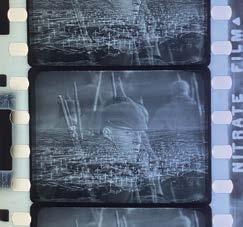
ISSN 2169-0863 (online)

Carla Hayden
Librarian of Congress
April Slayton
Executive Editor
Mark Hartsell
Editor
Ashley Jones
Designer
Shawn Miller
Photo Editor
Contributors
Connie L. Cartledge
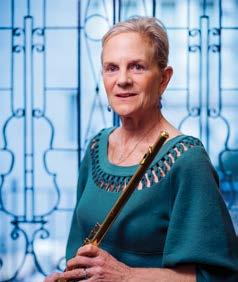
Sahar Kazmi
Wendi A. Maloney
Mike Mashon
Midori
Elizabeth A. Novara
Neely Tucker
Carol Lynn Ward-Bamford
MARCH/APRIL 2023 LOC.GOV/LCM 1 DEPARTMENTS
2 Trending 3 Favorite Place 4 Curator's Picks 5 For You 6 Technology 10 Page from the Past 12 Online Offerings 13 My Job 24 Around the Library 25 News Briefs 26 Shop the Library 27 Support the Library 28 Last Word 4 6 13 28 CONNECT ON loc.gov/connect
▪ Light glints off the chromium-plated keys of a Plexiglas flute made by Gebrüder Mönnig in 1937, now in the Library’s Dayton C. Miller collection. The interior of the flute is shown on the opposite page. Shawn Miller
LIBRARY OF CONGRESS MAGAZINE
TRENDING
▪ Left: Supreme Court Justices Potter Stewart and Harry Blackmun made a wager on the 1975 Red Sox-Reds World Series. Stewart wrote this note to Blackmun following the Reds’ victory. Manuscript Division



Center: Stewart’s clerks sent this update — a batter-by-batter account of the Reds’ first inning in Game 5 of the 1973 NLCS — to him during court proceedings on Oct. 10. Manuscript Division
Right: A note later that day relayed two important pieces of news: Vice President Spiro Agnew had just resigned and the Mets led the Reds, 2-0. Manuscript Division
SUPREME FANS
Notes reveal the high court justices’ passion for baseball.
A benefit of Library collections is that they often allow us to see a private side of famous folks — their happinesses and heartaches, everyday pleasures and passions.
As baseball prepares for opening day, the papers of Supreme Court Justice Harry A. Blackmun make a fitting case in point: They reveal Blackmun and other justices as avid fans of the game. During oral arguments, justices occasionally would exchange notes about goingson inside and outside of the court. Blackmun’s papers contain many examples, including some about baseball.
Several favorites pertain to the great Cincinnati Reds teams of the 1970s — the Big Red Machine of Pete Rose, Joe Morgan, Johnny Bench and Ken Griffey Sr.
On Oct. 10, 1973, the Reds faced the New York Mets in the decisive Game 5 of the National League Championship Series (NLCS). It was a day game, making it hard for fans at work or school to follow in an era without cell phones or internet.
Justice Potter Stewart, a fervent Reds fan, ordered his clerks to keep him apprised
during afternoon arguments via notes he then passed along to the other justices.
A first note chronicled in detail the Reds’ at-bats in the first inning. A second relayed huge political news — Vice President Spiro Agnew just resigned! — with an important addendum below: “METS 2 REDS 0.”
Two seasons later, the Reds faced the Boston Red Sox in the World Series, considered one of the greatest ever played. That, too, is documented in the Blackmun papers.
Notes reveal that Blackmun and Stewart made a wager on the series: Blackmun bet $2.50 on Boston, Stewart $4 on Cincinnati (about $20 today). The Reds rallied to win a dramatic Game 7, earning their first championship in 35 years.
In a note to Blackmun the next day, Stewart was gracious in victory: “It was a great Series, and the Reds were darn lucky to win.”
History won, too, because Blackmun saved the notes, allowing us a glimpse of the personal lives of the justices and their interactions on the court.
—Connie L. Cartledge is a senior archives specialist in the Manuscript Division.
2 LIBRARY OF CONGRESS MAGAZINE
FAVORITE PLACE
IN BLOOM
Spring brings life and color back to the Capitol campus.
Each March, winter makes its last stand in the nation’s capital. By the middle of the month, the threat of one last snow melts away and spring fitfully emerges from hibernation.
Come April, the U.S. Capitol campus flowers into color and life. Tulips, crocuses and daffodils bloom. Dogwood, magnolia and cherry blossoms fill the horizon, whichever way you turn. Down at the Capitol reflecting pool, ducklings paddle busily around their mothers.
Visitors, glad to finally shed layers of winter wear, arrive in larger numbers. They stroll the wide walkways, looking for the perfect spot to snap the perfect photo: the Capitol dome framed by blossoms.
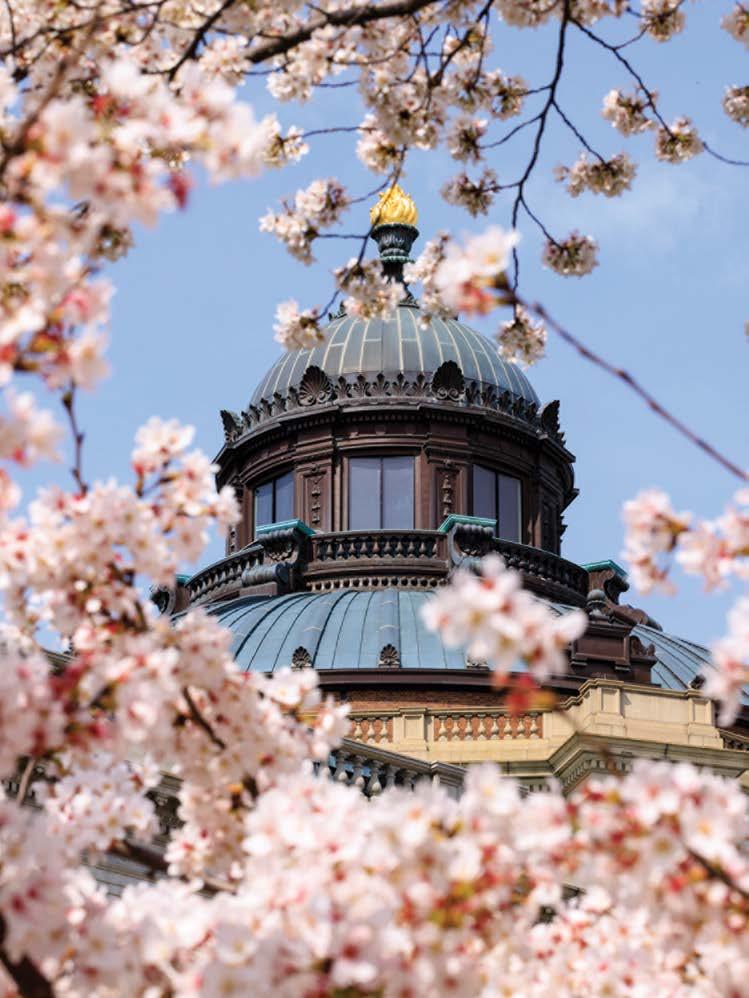
Unbeknownst to most passersby, the campus’ trees often hold special meaning.
A swamp white oak on the southwest grounds memorializes lives lost in the Sept. 11 terrorist attacks. An American sycamore commemorates Emmett Till, the young African American whose killing in 1955 helped galvanize the civil rights movement. Five Japanese flowering crabapples honor the five Sullivan brothers, all of whom served aboard the USS Juneau in World War II, all of whom were killed when the ship was torpedoed and sunk in 1942.
A favorite tree stands — or, rather, leans precipitously — at the southeast corner of the Library’s Jefferson Building. The yoshino cherry is one of over 3,000 such trees given by the city of Tokyo to Washington, D.C., in 1912 as a token of friendship.
The tree has seen many seasons — and many generations of Library workers — come and go. Now, deep into old age, it rests heavily upon a wooden crutch, its gnarled trunk nearly parallel to the ground. Still, it produces masses of pinkish-white blooms — a welcome sign that spring has returned and that, as the years pass by, some things remain beautifully the same.
—Mark Hartsell is editor of LCM.
MARCH/APRIL 2023 LOC.GOV/LCM 3
SHAWN MILLER
CURATOR'S PICKS
THE OSCAR GOES TO …

Mike Mashon, head of the Moving Image Section, chooses favorite Academy Award-related items from the Library’s collections.
‘THE WAY OF ALL FLESH’ PRESS KIT
German actor Emil Jannings won the first best actor Oscar for two films, “The Last Command” and “The Way of All Flesh.” The latter is a “lost” film; that is, no copies are known to survive. A 35 mm print was registered for copyright in October 1927 but, because the Library did not retain nitrate film until the 1940s, was returned to Paramount. We did, however, keep the press kit that was submitted along with the film.

BOB HOPE’S NOTECARD
Comedian Bob Hope hosted the Academy Awards ceremony a record 19 times from 1940 to 1978. From the very start, he did a running gag about not winning an Oscar himself, as seen in this note card he carried with him onstage in 1942. His most memorable joke came in 1968: “Welcome to the Academy Awards,” he quipped, “or as they’re known at my house, Passover.”

ON THE RED CARPET
Kemp Niver was important to the Library because he led a 15-year preservation project on the earliest films registered for copyright on rolls of paper. But as an employee of the Academy of Motion Picture Arts and Sciences, he also shot delightful behind-the-scenes footage of the 1958 awards, including the absolute chaos that was the red carpet in the days before what we now think of as the Oscar pre-show. Here, Bette Davis makes her way through the throng.

‘ALL QUIET ON THE WESTERN FRONT’
The third bestpicture Oscar went to the powerful antiwar film “All Quiet on the Western Front” in 1930. The Library holds a wealth of original nitrate elements in the Universal Collection. It restored the film by combining versions made for American and foreign audiences as well as a silent version with a synchronized soundtrack.

OSCARS ON THE RADIO
The Oscars were first televised in 1953 but had been broadcast on radio since the second ceremony, in April 1930. The Library holds a set of NBC program cards that provide nearly comprehensive information about what was broadcast on the network from 1930 to 1960. This card is from the opening of the Feb. 27, 1941, ceremony that featured an address from President Franklin D. Roosevelt.

4 LIBRARY OF CONGRESS MAGAZINE
NATIONAL AUDIO-VISUAL CONSERVATION CENTER
‘JOIN IN’
Exhibit explores America’s tradition of volunteering for common purposes.

America always has been a “nation of joiners”; it’s part of the collective DNA.
A new exhibition at the Library, “Join In: Voluntary Associations in America,” explores our long tradition of volunteering for a wide range of groups and causes.
Since the earliest days of English colonization, Americans have organized themselves in self-governing groups for common purposes: fellowship, charity, professional growth, emergency services, societal reform, community building.
In 1620, passengers on the Mayflower signed the Mayflower Compact, thus forming a “civil body politic” that allowed them to function as a unit until they were granted a warrant to form a new colony. The original compact no longer exists, but the Law Library of Congress holds the earliest surviving text: “Mourt’s Relation,” printed in 1622 and now part of the exhibition.
Artifacts tell stories of well-known groups in American culture: the Salvation Army, the American Federation of Labor, the NAACP, Alcoholics Anonymous, the National Parent Teacher Association, the American Red Cross.
FOR YOU
After learning of the International Red Cross, Clara Barton formed the American National Red Cross in 1881 to organize a system for national relief to mitigate “sufferings caused by war, pestilence, famine and other calamities.” The Library holds the group’s original articles of incorporation and papers, highlighted in the exhibition.
Over the course of U.S. history, these groups at times reflected society’s discriminations and divisions.
Although the first American lodges, established as men’s fraternal associations in the 18th century, advocated for egalitarianism and tolerance, many excluded African Americans.
After being refused membership in Boston lodges, Prince Hall, a leather worker, abolitionist and Methodist lay minister, secured a British charter to open a lodge in 1784 for Black men in America. Since then, Prince Hall freemasonry has advocated for African American citizenship, education and civil rights.
Through the Dec. 31 closing, visitors to the exhibition can explore America’s history of engagement through voluntary groups — a tradition that connects with the nation’s founding and continues today.
MORE INFORMATION
‘Join In: Voluntary Associations in America’ loc.gov/exhibits/
MARCH/APRIL 2023 LOC.GOV/LCM 5
▪ Visitors explore the new ‘Join In’ exhibition in the Library’s Jefferson Building. Shawn Miller
TECHNOLOGY
▪ Above: Innovator in Residence Jeffrey Yoo Warren. Mia Warren

Below right: Yoo Warren’s relational reconstruction technique applies archival photographs to building surfaces constructed in a 3D modeling program.
Jeffrey Yoo Warren
Opposite, top: Yoo Warren connects archival photographs to street locations on a historical map of Providence, Rhode Island. Jeffrey Yoo Warren
Opposite, bottom: An example of an archival photograph “flattened” from its original perspective in preparation to be applied to a 3D facade.
Jeffrey Yoo Warren
SEEING LOST ENCLAVES
Communities reconstructed using 3D technology and Library collections.
The Library boasts many ways historylovers can immerse themselves with its treasures from afar. They can explore online collections, tune in to virtual lectures and discover extraordinary tales on our blogs.
Now, 2023 Innovator in Residence Jeffrey Yoo Warren is building another doorway to the past with his project, “Seeing Lost Enclaves: Relational Reconstructions of Erased Historic Neighborhoods of Color.”
Using 3D modeling techniques and insights from the collections, Yoo Warren is developing a virtual reconstruction of the once-bustling Chinatown district in Providence, Rhode Island. A vibrant enclave 100 years ago, it largely has been erased from historical memory.

In his work with the Library, Yoo Warren will expand his research to include other early 20th-century Chinatowns in places such as New Orleans, Denver and Truckee, California.
Using the Library’s archival photos, newspapers, maps, film and audio
recordings as well as work with local communities, Yoo Warren’s “relational reconstruction” process aims to make these places “visitable” again, if only virtually. He’ll also experiment with multisensory elements like virtual weather and soundscapes.
The full effect, he hopes, will give audiences a visceral — and maybe even deeply personal — feeling of walking into a forgotten reality.
Although his 3D visualization is centered on Chinatowns, Yoo Warren’s work also will produce a “relational reconstruction toolkit” to inspire the public to develop similar recovery efforts for other ancestral spaces. The toolkit will feature resources and
6 LIBRARY OF CONGRESS MAGAZINE
tutorials on using the Library’s place-based materials to reclaim lost histories through immersive digital reconstructions.
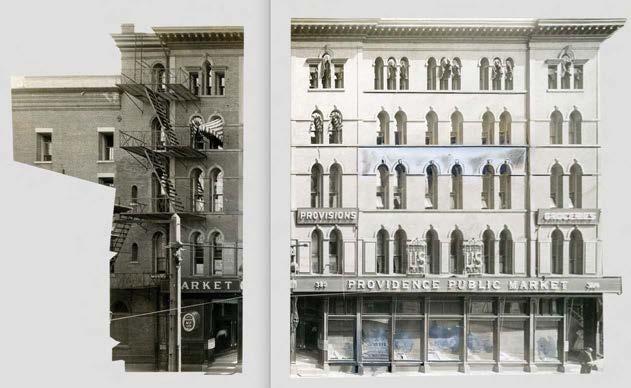

As an artist and educator, Yoo Warren believes the historical erasure he’s addressing is not only a challenge of archival documentation but a matter of community meaning and loss. In creatively rebuilding the sights, sounds and emotions of lost spaces, his work will help the Library enrich the nation’s cultural memory and, with some technological help, construct another bridge between the records of the past and the potential of tomorrow.
—Sahar Kazmi is a writer-editor in the Office of the Chief Information Officer.
MARCH/APRIL 2023 LOC.GOV/LCM 7
THE ULTIMATE ‘ULYSSES’
Joyce inscribed this unforgettable copy of his great novel to a friend.
BY NEELY TUCKER
▪ A four-page outline, located in the back of this extremely rare copy of “Ulysses,” explains the novel’s convoluted plot and its connection to “The Odyssey.” Rare Book and Special Collections Division

Paris, 1922: Sylvia Beach, proprietor of Shakespeare and Company, the famous bookshop, decides to publish “Ulysses,” the modernist novel by James Joyce. This is risky because prepublication excerpts had been declared obscene by U.S. courts. Beach limited her first edition to 1,000 copies. All were numbered, and 100 were signed by the author. It was a brilliant decision. The novel went on to be regarded as one of the premier literary works of the 20th century and Joyce one of the era’s great authors. Copies of that first print run became some of the most sought-after books of the age.
And yet all of that scarcely begins to describe the first edition of “Ulysses”
8 LIBRARY OF CONGRESS MAGAZINE
acquired in 2020 by the Library. It’s a marvel to behold: Copy #361 is bound in bespoke calfskin, front and back covers initialed by the author, the title page inscribed by Joyce to a friend, with inserts that include Joyce’s own guide to deciphering the book.
Two other “Ulysses” first editions were included in the acquisition of the Aramont Library (the property of a private owner), including the signed #1 copy — the first copy of the first edition, an almost unbelievable find of such an important book.
“All of these copies are exceptional, but there is one that is truly unique,” said Stephanie Stillo of the Rare Book and Special Collections Division, indicating the custommade copy.
Joyce, a native of Ireland, spent years laboring over the stream-of-consciousness novel while living in Europe. It’s the story of one day in Dublin — June 16, 1904 — in the life of antihero Leopold Bloom. It’s modeled on Homer’s epic poem “The Odyssey,” told in 18 chapters in almost bewildering fashion. One sentence runs 4,391 words. As the British Library sums it up “… each episode is represented by a different organ of the body, colour, symbol, technique, art, place and particular time of day.”
Beach, a friend of many modernist artists, published the first copies on Feb. 2, 1922, Joyce’s 40th birthday.
While finishing the book, Joyce befriended a young French admirer, Jacques BenoistMéchin. Just 20 years old, Benoist-Méchin was a promising intellectual who helped Joyce finalize the book’s famous last sentences, a soliloquy by the fictional Molly Bloom.
They apparently worked together to make #361 an unforgettable copy. Joyce inscribed the copy to him. A sketch map of Dublin adorned the front, as it was the book’s setting. The back cover was a sketch map of Gibraltar. This was a nod to Benoist-Méchin’s help in interpreting Molly’s famous closing scene; in the book, she is born in Gibraltar.
But the real gems were at the back.
A four-page scheme, or outline, explains the book’s convoluted plot and its symbolism, including Joyce’s notation that the book was based on “The Odyssey,” without which the world might never have noticed the correlation. (Only seven of these outlines
are known to exist.) Then, another stunner — a full-color foldout anatomical chart of a human body, likely taken from a medical textbook, annotated in red ink, noting how each body part relates to the plot. Finally, tucked inside this copy are portraits of Joyce (likely taken by famed photographer Man Ray) and Beach and a letter from Joyce to Benoist-Méchin.
The final twist: Benoist-Méchin grew into a prominence of his own as a historian and journalist who enthusiastically collaborated with Nazi Germany’s takeover of France in World War II. He was condemned to death as a traitor after the war and eventually had his sentence commuted after seven years in prison.
All of that 20th-century history, bound in one completely original book. It’s something to behold.
—Neely Tucker is a writer-editor in the Office of Communications.
▪ The volume also includes a foldout anatomical chart, noting in red ink how each body part relates to the plot of “Ulysses.” Rare Book and Special Collections Division

MARCH/APRIL 2023 LOC.GOV/LCM 9
PAGE FROM THE PAST
▪ Opposite: In 1562, the cosmographer to King Philip II created this map showing Spain's territorial claims in the New World. The Library's copy is one of only two known to exist. Geography and Map Division
Right: Just above the Tropic of Cancer, the map identifies “C. California” — the first time the name “California” appears on a printed map. Geography and Map Division
PUTTING CALIFORNIA ON THE MAP
With a magnificent and groundbreaking map, Spain proclaimed its empire to its 16th-century rivals in Europe — and helped bestow a name on California.
At that time in Europe, authoritative knowledge of the New World’s geography was based upon the observations of primarily Spanish- and Portuguesesponsored expeditions that crossed the Atlantic to explore uncharted places.
The information they acquired was vital to Spain’s status as a world power. After all, the Spanish could better claim an empire if they could show these new territories on a map.
In 1562, Diego Gutiérrez, the principal cosmographer to King Philip II of Spain, created a map of the Western Hemisphere to serve that purpose.
Gutiérrez’s map spreads across six sheets that, when joined, measure 36 by 33 inches. Only two copies are known to exist: One at the Library of Congress, another at the British Library.
The map, titled “Americae sive qvartae orbis partis nova et exactissima descriptio,” wasn’t intended to be a scientifically exacting document. Instead, it served as a diplomatic tool to assert Spain’s claims to New World territories against rival claims by Portugal and France.
The map was engraved by Hieronymus Cock of Antwerp, one of the most important engravers and printmakers of 16th-century Europe. Cock added numerous artistic flourishes — monkeys, mermaids, fearsome sea creatures, cannibals, Patagonian giants, an erupting volcano — to complement the
settlements, rivers, mountains and capes named.
The map correctly recognizes the Amazon River system, Lake Titicaca, Mexico City, Florida and the southeastern portion of the present-day United States, as well as myriad coastal features of North, South and Central America and the Caribbean.
Squeezed in at the left edge, just above the Tropic of Cancer, Gutiérrez added something new: “C. California” — the first time the name “California” appears on a printed map. To claim an empire, one must show that it exists and to whom it belongs. With this map, Spain and Gutiérrez did just that.

A work by Diego Gutiérrez helped establish Spain’s claims in the New World.
MORE INFORMATION Gutierrez’s New World map loc.gov/resource/g3290.ct000342/ 10 LIBRARY OF CONGRESS MAGAZINE
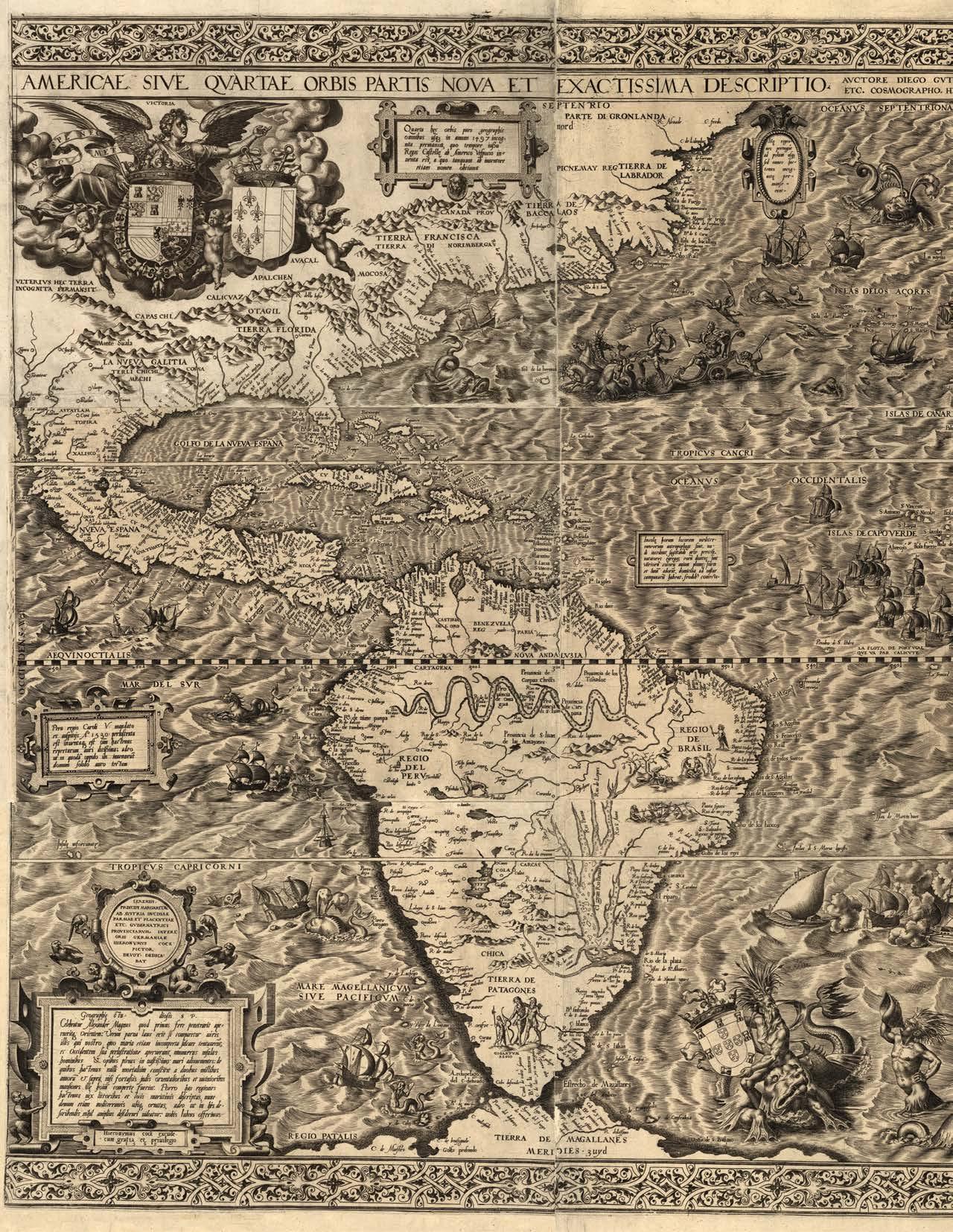
ONLINE OFFERINGS
PATHWAYS TO WOMEN’S HISTORY
Guide series helps researchers navigate rich collections.
The American Women Research Guide Series, recently revised and updated online, makes the unparalleled women’s history collections and resources at the Library more easily discoverable by researchers.
Originally published in book form as American Women: A Library of Congress Guide for the Study of Women’s History and Culture in the United States, an online version of the guide appeared soon afterward on the Library’s former American Memory website.

Over the last several years, librarian subject specialists have migrated information to a new online format (Springshare’s LibGuides) and updated this information to reflect new collections, tools and resources, including newly digitized collections available via the Library’s website.
Currently, one overarching guide provides an introduction to researching women's history at the Library and brings together 11 distinct research guides, as well as a collection of topical essays. Each of the 11 research guides represents a different research center at the Library and underscores the diversity of formats and subject areas available to researchers.
The topical essays are gathered in a separate guide, showcasing themes such as patriotism in early America, women’s overland journeys to California, women’s suffrage, the MacDowell Colony, the Equal Rights Amendment and women as symbols in America.
In no way intended to be exhaustive, the American Women Research Guide Series instead provides pathways into the Library’s rich collections.
Among the multitude of materials highlighted across divisions are Wonder Woman comic books and posters from the Women’s March; sheet music by composer Amy Beach; original letters by first lady Abigail Adams; papers of congresswoman Patsy T. Mink and of LGBTQ+ activist Lilli Vincenz;
scrapbooks of suffragists Elizabeth Smith Miller and Anne Fitzhugh Miller; moving image and audio recordings of poetry readings by Maya Angelou, Ana Castillo and Rita Dove; and countless cookbooks, etiquette manuals, sex manuals, legal treatises, maps, newspapers and government publications.
—Elizabeth A. Novara is a historian in the Manuscript Division.
MORE INFORMATION
Women's History Resources guides.loc.gov/american-women
▪ Top: First lady Abigail Adams wrote this 1799 letter to sister Elizabeth Smith Shaw Peabody, asserting that she “will never consent to have our sex considered in an inferiour point of light.” Manuscript Division
Bottom: Women pose with African American educator, feminist and civil rights activist Nannie Helen Burroughs (left) in the early 1900s. Prints and Photographs Division
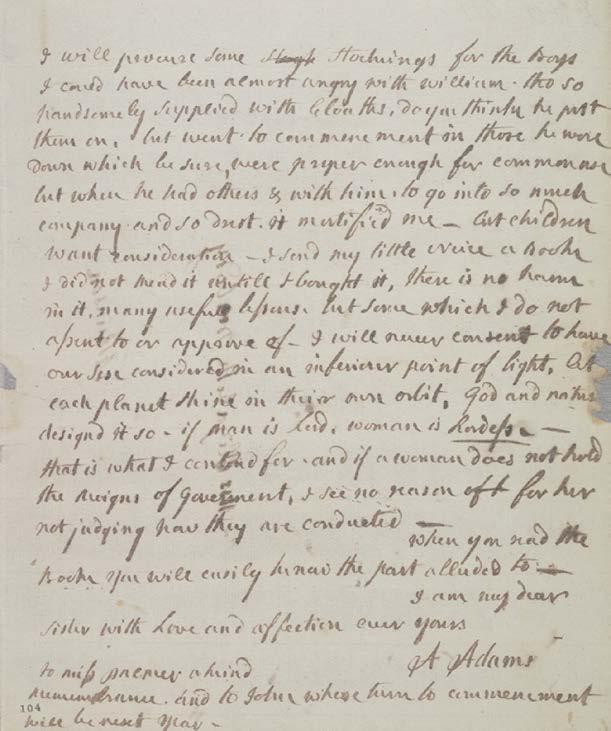
12 LIBRARY OF CONGRESS MAGAZINE
Carol Lynn Ward-Bamford curates collections of musical instruments.
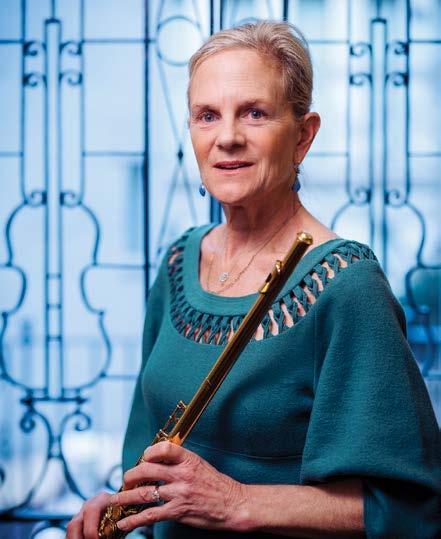
Describe your work at the Library.
I take care of the musical instruments collections in the Music Division. The Library has over 2,000 instruments — mostly woodwinds and bowed stringed instruments — that are available for study, performance and exhibition.
My days are spent managing their care; their use in public performances, displays and exhibitions; and visitor requests to see, examine or copy them. The Dayton C. Miller flute collection comprises not just the flutes themselves but also an entire reference collection of related books, music scores, patents, iconography, statues, photographs and more. So, I often work with different divisions at the Library and many types of visitors.
How did you prepare for your job?
I went through graduate school in music and performance on the flute. I taught flute, freelanced, played with an orchestra and worked in a flute manufactory. One day, literally, I just felt I had accomplished all I wanted to do on the flute. After considering further studies in musicology, I decided instead to be a librarian.
Off I went to library school at Simmons University. Next door was the Museum of Fine Arts, Boston. I started work there in the musical instruments department, and that was that! I knew I was in the right place. At the same time, I took a publishing class at Simmons. For my final project, I created a catalog of the Miller flute collection and was told to show it to the Library’s Music Division. So, I did.
I applied for a temporary job here at the Library and got hired for 120 days. That was good enough for me. I eventually got a permanent job and turned that final school project into the Library’s Dayton C. Miller website.
I feel that working with researchers, visitors, the public and our staff and fielding all their questions that I am at work on a Ph.D. in “how to answer”!
What have been your most memorable experiences at the Library?
Before the visit of singer-songwriter Lizzo to the Library’s flute collection: getting my first thank you note. It was from a young girl, filled with her words and drawings of flutes. I have it in my office, where I see it every day. I was so grateful she sent it because that made me realize we can have an impact, no matter what the age of the visitor.
Also before Lizzo: the power of collaborating with other divisions and institutions. I worked as part of a team with the Library’s Preservation Research and Testing Division, Catholic University and George Washington University studying our glass flutes via a three-year major grant from the National Endowment for the Humanities.
Then there was the visit to the Library by Lizzo and the concert at Capital One Arena the next day at which she played our flute that once belonged to James Madison. While that event was one of the hardest days of my Library life, it also was one of the best. It had great impact on the Library and the flute in general.
And everyday memories: the power of donors and their generosity.
MARCH/APRIL 2023 LOC.GOV/LCM 13
SHAWN MILLER
MY JOB
How
FABULOUS FLUTES
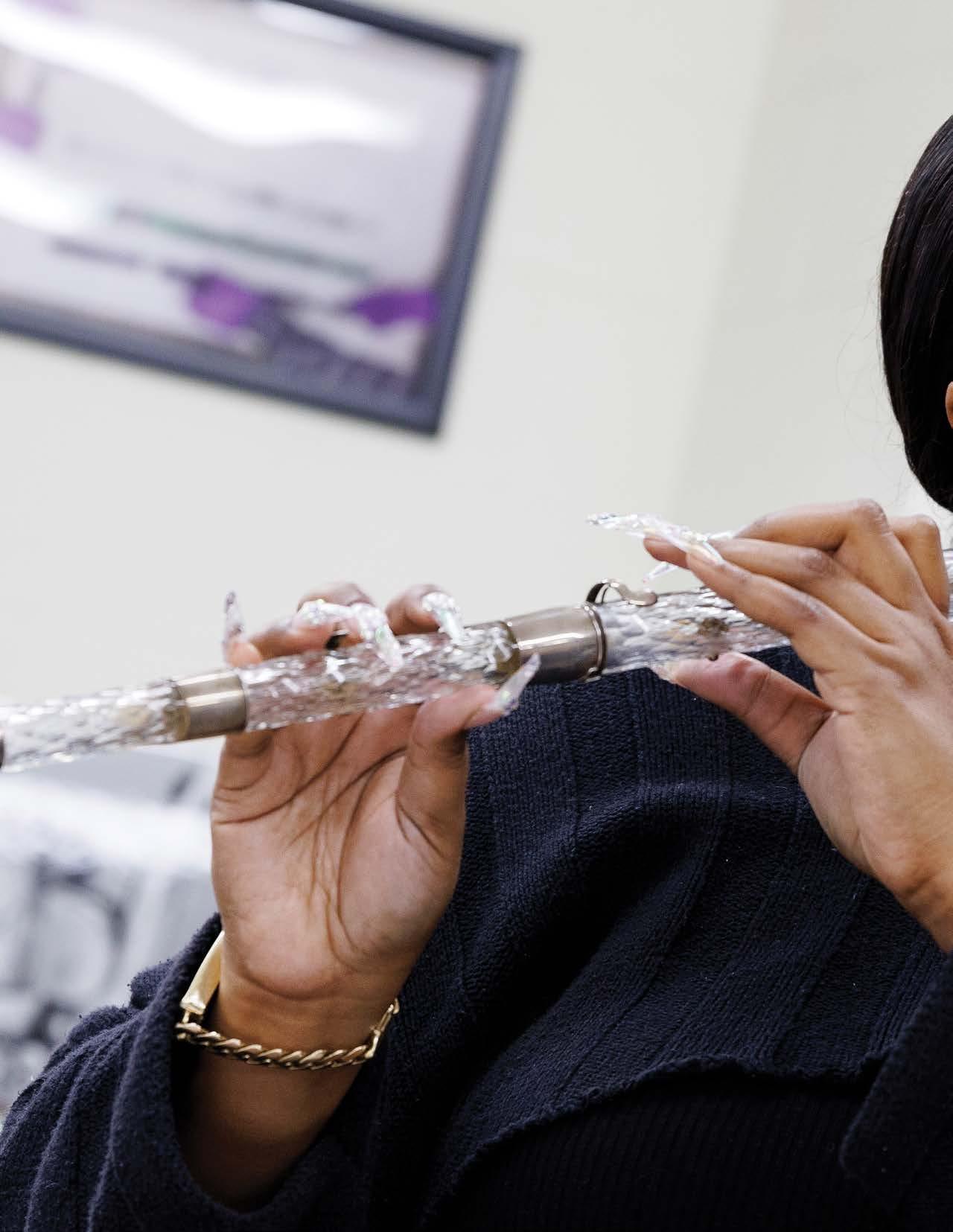 BY MARK HARTSELL
BY MARK HARTSELL
a scientist built the greatest collection ever assembled on a single music subject.
14 LIBRARY OF CONGRESS MAGAZINE
Call it the flute heard ’round the world. Standing in the Great Hall last fall, Grammywinning singer-songwriter Lizzo gave an impromptu performance on one of the Library’s most-prized musical instruments: a rare crystal flute that once belonged to President James Madison.

The next night, she and the flute reprised the performance at her Capital One Arena concert before thousands of adoring fans, holding their phones aloft to record the scene for posterity and TikTok.
“I want everybody to make some noise for James Madison’s crystal flute, y’all,” said Lizzo, who then advised the crowd about the difficulties of playing such an unusual instrument: “It’s crystal — it’s like playing out of a wine glass!”
The combination of Lizzo and Madison set social media afire: A behind-the-scenes video of her Library visit drew record (for the institution) views — nearly 7 million on the Library’s main Twitter, Facebook and Instagram accounts. The concert performance likewise drew millions of views elsewhere in the social media universe and coverage from dozens of media outlets.
The instrument that helped set off the bedlam is one of the most prominent pieces in a collection donated to the Library in 1941 by physicist, astronomer and major flute aficionado Dayton C. Miller. The collection is not just the world’s largest of flute-related material, it is perhaps the largest collection on a single music subject ever assembled — and it’s what drew Lizzo to the Library in the first place.
The Miller collection contains nearly 1,700 woodwind instruments spanning five centuries; over 10,000 pieces of sheet music and 3,000 books; some 700 prints, etchings and lithographs; more than 2,500 photographs; scores of bronze statues and porcelain and ivory figurines; plus patents, trade catalogs, news clips, correspondence and autographs.
The flutes cover an enormous range of cultures, materials, shapes and sizes. Collectively, they tell the story of the instrument’s history. Many of the individual pieces have their own stories.
MARCH/APRIL 2023 LOC.GOV/LCM 15
▪ Singer-songwriter Lizzo plays a crystal flute that once belonged to President James Madison while at the Library last fall. Shawn Miller
The crystal flute played by Lizzo was created in 1813 by French maker Claude Laurent and presented to President Madison on the occasion of his second inauguration — two silver ferrules on the instrument are engraved, in French, with Madison’s name and title. It’s believed that Madison’s wife, Dolley, rescued the flute from the White House when the British burned the capital in 1814, during the War of 1812.

Another flute, stored in a plush porcelain casket, once belonged to 18th-century Prussian monarch Frederick the Great, one of history’s most famous amateur musicians. Frederick maintained an excellent court orchestra and composed music for it himself; the Miller collection includes not only the king’s flute but original manuscripts of his compositions.
There are instruments made of gold, silver, glass, jade, tortoiseshell, boxwood, bamboo, ivory, bone and cocus, a West Indian tree that furnishes a fine green ebony. Some take most-unlikely forms: a gavel, walking sticks, birds, a four-legged mammal and what appears to be a horned toad climbing a tree.
They span continents and cultures: xiaos from China and flageolets from England, Egyptian zummāras, Bulgarian kavals, Japanese shinobues, northern Italian panpipes and a Native American courting flute decorated with a stag’s head and the sun and moon.
The flute that inspired Miller’s interest — listed as item No. 1 in his ledger — is a fragment of a humble rosewood fife his father played in the Union Army during the Civil War.


The collection reflects the man who created it more than a century ago — Miller possessed a deep and practical mind and an inquisitive nature. Even given his passion for music and an artistic bent, he remained a scientist first.
“A comprehensive appreciation of the art of the flute requires, besides a knowledge of music in general, also a knowledge of the physical principles of the flute as a sound producing instrument, of the mechanical devices by which these principles are used,” he would write in 1935.
Miller grew up in a small Ohio town, obsessed with science and music: At his graduation from Baldwin Wallace College, he delivered a lecture about the sun and, as part of the ceremony, played the
16 LIBRARY OF CONGRESS MAGAZINE
▪ The collection built by Dayton C. Miller (top) included this humble wooden fife played by his father in the Civil War (left) and this elegant crystal instrument that belonged to President James Madison. Music Division
▪ The Miller collection encompasses many forms, materials and cultures: From left, a glass flute made in Paris by Claude Laurent; a wood and brass haidi from China; a birddecorated whistle from Switzerland; and an ebony flute that once belonged to Frederick the Great, the king of Prussia. Music Division
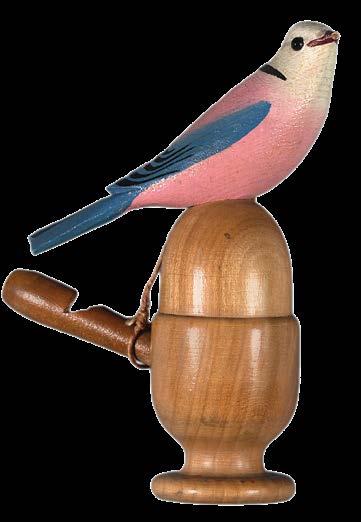



MARCH/APRIL 2023 LOC.GOV/LCM 17
flute — a transcription of the largo from Beethoven’s Piano Concerto No. 1. He earned a Ph.D. in astronomy from Princeton and taught physics at the Case School of Applied Science in Cleveland for a half-century. He debated with Albert Einstein about ether drift theory, and when they met at Case, Einstein signed Miller’s ledger book.
Miller pioneered the use of X-rays in medicine. In 1896, he learned of the discovery of X-rays by a German scientist, promptly built his own apparatus and began experiments. He made a composite, full-length X-ray of his own body. He photographed a boy’s broken arm and produced what perhaps was the first X-ray used for surgery in America. He delivered more than 70 lectures around the U.S., promoting the use of the X-ray.
Miller became an expert on acoustics and invented the phonodeik, a device that converted sound waves into visual images. Among other uses, he employed the machine to compare waves produced by flutes made from different materials. During World War I, he studied the pressure waves caused by the firing of artillery, providing material for
medical investigations of shell shock. Armed with a passion for music and a knowledge of the physics of sound, Miller also became one of the world’s foremost experts on the flute. He developed into an excellent amateur player. By the 1890s, he was a serious collector of all things flute: instruments, books, scores, images, statues, you name it.
He came along at the right time: Few other serious collectors were around to compete for prize pieces, making the market affordable.
The Miller collection contains, for example, 18 crystal flutes from the early 19thcentury Paris workshop of Laurent. In 1923, Miller paid $200 (about $3,500 in today’s dollars) for the Madison flute — an incredible bargain for an instrument that is both of a rare type and, by its association with the president, an irreplaceable, one-of-a-kind historical object. In 1940, he bought an 1815 Laurent glass flute from the British firm Rudall Carte for 10 pounds (about $40 at the time, according his ledger, and around $850 today).
Given his nature, Miller wouldn’t be content to merely collect.

18 LIBRARY OF CONGRESS MAGAZINE
▪ Miller collection flutes lie in individual custommade containers in a climate-controlled space at the Library. Shawn Miller
He also composed music: Two pieces, “A Lover’s Prayer” and “The Audacious Jewel,” were dedicated to his wife, Edith Easton. He built several of his own flutes — he had learned to make things in the tin shop at the rear of his dad’s hardware store in Berea, Ohio.
In 1901, he built a flute of silver at a cost of $44 in material and special tools. He once played a gold flute in London and thought it the finest instrument he’d ever played. So, he built his own. Miller kept an elaborate log of each procedure and the time required to complete it — the entire process took over 3 1/2 years. The finished flute featured a tube of 22-karat gold, a mechanism of 18-karat gold and fingering and tuning features not incorporated together on any other instrument.
He was such an expert that flutemakers traveled great distances to consult with him on manufacturing their instruments, to gain insight from his personal knowledge and from the collection he had amassed.
Today, 82 years after Miller’s death, folks still do, in a way.
Researchers and musicians, like Lizzo, from around the world still come to the Library, to see and to study the greatest flute collection ever assembled.
▪ Left: Miller pioneered the use of X-rays in medicine. To help illustrate their value, he made this composite, full-length X-ray of his own body. Music Division

Below: Miller made meticulous notes on each item in his collection. Here, he describes a cocus wood flute that he purchased from George W. Haynes in 1919 for $95 — a large sum at the time. Music Division
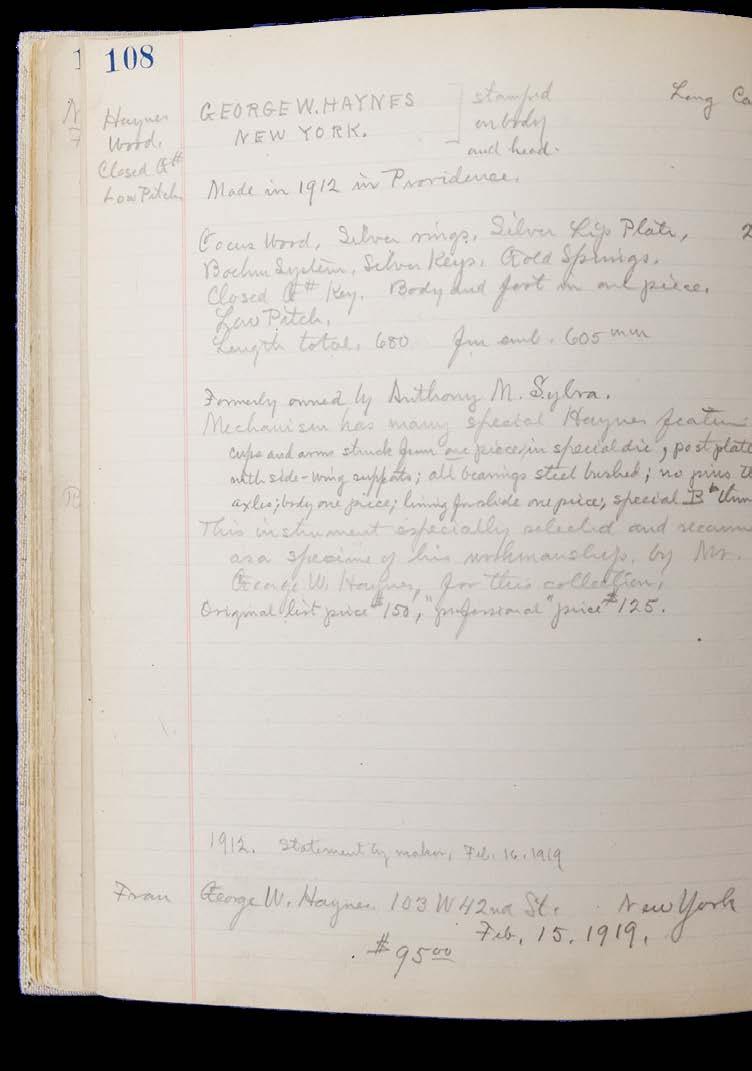
MARCH/APRIL 2023 LOC.GOV/LCM 19
Rare 16th-century manuscript sheds light on Indigenous life under Spanish rule.

THE SAN SALVADOR CODEX
BY WENDI A. MALONEY
20 LIBRARY OF CONGRESS MAGAZINE
Theft, fraud, harassment, withholding of payment — courts around the world hear these charges all the time. Yet, they’re far from a new problem. The Library’s recently acquired San Salvador Huejotzingo Codex, for example, documents a legal proceeding from 1571 in which Indigenous Nahuatl officials in central Mexico accused their village’s Spanish administrator of these very crimes.
The codex, purchased by the Library last fall, contains new details about the earliest legal structures in Mexico after Spanish colonization and the way Indigenous people used Spanish laws to defend their rights. The codex is one of only six 16th-century pictorial manuscripts from central Mexico known to still exist. With its acquisition, the Library now holds three of them: the 1571 San Salvador Huejotzingo Codex, the 1531 Huexotzinco Codex and the 1593 Codex Quetzalecatzin.
“The San Salvador Codex adds significantly to the Library’s collection of Indigenous manuscripts from the early contact period,”
said John Hessler, formerly of the Library’s Geography and Map Division. “It is by any measure a world-class acquisition.”
The manuscript consists of 96 pages on 48 folios and includes six foldout drawings in Mixtec and Nahuatl hieroglyphs in red, yellow, coffee, green, blue and black carbon ink. Written by at least two different Indigenous hands, the hieroglyphs illustrate charges against Alonso Jiménez, the canon of San Salvador, a village south of what’s now Mexico City. Jiménez, a church official, administered the village on behalf of Spanish colonial authorities.
▪ Opposite and above: The San Salvador Codex includes six foldout drawings in Mixtec and Nahuatl hieroglyphs in red, yellow, coffee, green, blue or black carbon ink. Geography and Map Division

MARCH/APRIL 2023 LOC.GOV/LCM 21
Two lawsuits arose after a colonial inspector arrived in San Salvador unannounced in 1570 to assess how well it was being managed. The Indigenous people reported mistreatment and harassment of their nobles and accused Jiménez of refusing to pay for the services of artisans, charging for woolen blankets meant to be free, taking more corn than the church was entitled to and stealing textiles.
“It gives you insight into what life was like in this village,” Hessler said. “People are helping the canon make his furniture. They’re farming corn and getting woolen blankets, and they’re also being exploited. We get a real sense of the everyday out of this document, which makes it so important.”
One drawing depicts different amounts of maize, tortillas and other foodstuffs provided to Jiménez as tribute from 1570 to 1571. Another features the faces and names of carpenters not paid for constructing the local church and making Jiménez’s furniture. Yet another represents the value of paintings

done for him in tortillas — it shows how many tortillas each painting was worth. Before the codex came on the market, scholars didn’t know it existed — it did not appear on any of the inventories of Mesoamerican manuscripts or Indigenous drawings. In addition, only three colonial-era manuscripts with Indigenous drawings, plans or maps have come up for sale in the past century.
“It is a super-rare opportunity when one gets a chance to buy something like this,” Hessler said. “We have been so lucky in the last five years to purchase two of these, the Codex Quetzalecatzin and also this one.”
The Codex Quetzalecatzin is a map that shows genealogical information and land ownership for the Nahuatl de Leon family from 1480 to 1593 — one of the most important Indigenous manuscripts from the earliest history of the Americas to become available in the last century.
The Huexotzinco Codex, acquired in the late
22 LIBRARY OF CONGRESS MAGAZINE
▪ The 1531 Huexotzinco Codex narrates a legal dispute and features testimony against representatives of the Spanish colonial government by the Nahua people of Huexotzinco. Geography and Map Division
1920s as part of the Edward S. Harkness Collection, narrates a legal dispute. It features testimony against representatives of the Spanish colonial government by the Nahua people of Huexotzinco.
What makes the newly acquired San Salvador Codex remarkable, Hessler said, is its completeness. The Huexotzinco Codex presents only the Indigenous side of a dispute. The 1540 Oztoticpac lands map, also part of the Library’s collections, relates to a lawsuit concerning the estate of an Aztec lord and also contains only Indigenous testimony. The San Salvador Codex, on the other hand, contains all the information about the lawsuits involved: the Indigenous testimony in Nahautl, the canon’s defense in Spanish, signatures of the parties and drawings. It even includes the verdict — the court acquitted the canon on some charges and found him guilty of others. As part of his penalty, he had to pay two pesos of gold to be shared among people who provided him with six jars of fig tree oil.
“It’s incredible, both in its detail and in the fact that you have the complete story,” Hessler said. “From that perspective, it is rare.”
Hessler traced the provenance of the San Salvador Codex to 19th-century France, where an aristocratic family long owned it. More recently, a Texas collector bought it, then sold it to the Swiss antiquarian dealer. A few months before the Library purchased the codex, the dealer flew it to the Library, where Conservation Division experts viewed it under ultraviolet light. Library curators, including Hessler, also examined it.
After the codex arrived at the Library, experts in the field came to view it — most prominently, Baltazar Brito Guadarrama, director of Mexico’s National Anthropology Library. Guadarrama, Hessler noted, had spent his career looking at such manuscripts and was moved to tears on seeing such a treasure in person — one of only few examples to endure the ravages of time.
—Wendi A. Maloney is a writer-editor in the Office of Communications.
▪ The Codex Quetzalecatzin shows genealogical information and land ownership for the Nahuatl de Leon family from 1480 to 1593. Geography and Map Division

MARCH/APRIL 2023 LOC.GOV/LCM 23
AROUND THE LIBRARY
1. Democratic freshmen members of the House of Representatives examine the James Madison crystal flute at an event in the Jefferson Building.

1. Workers install a new, state-of-the-art case for the Gutenberg Bible in the Great Hall of the Jefferson Building in November.
2. Singer Natalie Merchant examines a banjo at the American Folklife Center on Jan. 11. Merchant is a member of the center’s board of trustees.
2. Jorie Graham, recipient of the Rebekah Johnson Bobbitt National Prize for Poetry, reads selections from her work “Fast” on Dec. 6.
3. Librarian of Congress Carla Hayden (left) talks with Meg Medina, the new national ambassador for young people’s literature, on Jan. 24.

3. Students join Librarian of Congress Carla Hayden in the Great Hall to examine the Nicolay copy of the Gettysburg Address on the 155th anniversary of Lincoln’s historic speech.
4. A Christmas tree shines in the Great Hall on Dec. 12.
4. Visitors examine holdings from the Library’s Aramont collection of first editions, exhibition bindings and illustrated books on Jan. 19 in the Great Hall.


5. A visitor examines items from the Stephen A. Geppi Collection of Comics and Graphic Arts on display in the Great Hall on Nov. 9.
5. Student artists-inresidence tour the Thomas Jefferson’s library exhibition on Jan. 11.

6. House Speaker Kevin McCarthy swears in Republican Rep. Jenniffer González-Colón of Puerto Rico (right) on Jan. 10, using a Bible and a Library collections copy of a rare Wonder Woman comic book.

6. International Monetary Fund Managing Director Christine Lagarde delivers the eighth annual Kissinger Lecture on foreign policy, sponsored by the Kluge Center, on Dec. 4 in the Great Hall.
ALL PHOTOS BY SHAWN MILLER
ALL PHOTOS BY SHAWN MILLER
1.
3.
5.
4.
6.
2.
24 LIBRARY OF CONGRESS MAGAZINE
Medina Named Ambassador For Young People’s Literature
The Library of Congress and Every Child a Reader in January announced the appointment of Meg Medina as the eighth national ambassador for young people’s literature for 2023-2024.
Medina, a Cuban-American, is the first Latina to serve as national ambassador in the program’s history. She succeeds Jason Reynolds, who served as ambassador from 2020 through 2022.
Medina’s books examine how culture and identity intersect through the eyes of young people. Her middle-grade novel “Merci Suárez Changes Gears” received the 2019 Newbery Medal. Her most recent picture book is “Evelyn Del Rey Is Moving Away.”
For her two-year term as ambassador, Medina will engage readers across the country through her new platform, ¡Cuéntame!: Let’s Talk Books. Inspired by the Spanish phrase that friends and families use when catching up with one another, ¡Cuéntame! encourages connection among families, classrooms, libraries and communities by talking about books.
MORE: loc.gov/item/prn-23-004
Williams Appointed New General Counsel
Margaret Williams was named the Library’s new general counsel, effective Jan. 1. Williams has served at the Library for 35 years, most recently as deputy general counsel. She succeeds Elizabeth Pugh, who retired Dec. 31. Williams attended the University of Virginia, earned a master’s in library science from the University of North Carolina at Chapel Hill and then joined the Library’s FEDLINK program. After receiving a Juris Doctor from George Mason University, she joined the Office of the General Counsel at the Library in 1998 and, in 2015, became the institution’s first deputy general counsel.
Highlights of her legal career include contracting, grants and fiscal law work on contracting processes, revolving funds and the National Digital Information Infrastructure and Preservation Program. She also worked on the Teaching with Primary Sources program, fundraising and the Library’s ethics program.
MORE: loc.gov/item/prn-22-121
Seven Composers Receive New Music Commissions
The Serge Koussevitzky Music Foundation in the Library awarded commissions for new works to seven composers. The commissions are granted jointly by the foundation and the performing organizations that will present the world premiere of each work.
Winning composers for 2022 and the groups co-sponsoring their commissions are Marcos Balter and the New York New Music Ensemble; Oscar Bettison and loadbang; Eric Chasalow and Sound Icon; Amy Beth Kirsten and Sandbox Percussion; Nico Muhly and Nois; Jeffrey Mumford and the String Orchestra of New York City; and Tyshawn Sorey and Yarn/Wire.
The foundation again granted a commission in memory of composer Andrew W. Imbrie, a longtime Koussevitzky Foundation board member. This commission, inaugurated in 2021, is made possible through a gift from Barbara Cushing Imbrie and Andrew Philip Imbrie. Composer Eric Chasalow, sponsored by Sound Icon, is the 2022 recipient.
MORE: loc.gov/item/prn-22-110
Saylor Appointed Director Of American Folklife Center
Nicole “Nicki” Saylor has been appointed the fourth director of the American Folklife Center at the Library of Congress.
Before her new role at the center, Saylor served as chief of the Library’s Digital Innovation Lab, where she oversaw a team of innovation specialists exploring new technologies and creative ways to share the Library’s content and connect with researchers, artists and the public.
Saylor brings nearly 20 years of library and archives experience to the position, including her service as the director of the Archive of Folk Culture at the American Folklife Center from 2012 to 2021.
The American Folklife Center Archives collections span the earliest field recordings made in the 1890s on wax cylinders to borndigital collections such as StoryCorps, a large oral narrative project.
MORE: loc.gov/item/prn-22-043
MARCH/APRIL 2023 LOC.GOV/LCM 25
NEWS BRIEFS
SHOP
‘Not an Ostrich’ zine Product #21107191

Price: $19.95
Accompanying the Library’s namesake exhibition, “Not an Ostrich: & Other Images from America’s Library,” these images remind us not to take every photo at face value.
Library candle Product #21508223
Price: $38
This elegant 11-ounce candle is fragrant with eucalyptus, lavender and old books.

Storytime teddy bear
Product #21505250
Price: $14.95
This adorable plush bear loves books: His T-shirt proudly boasts Thomas Jefferson’s famous words, “I cannot live without books.”

Declaration glass Product #21505236
Price: $17.95
This 11-ounce rocks glass replicates the words of the Declaration of Independence.

‘Cherry Blossoms’ Product #21107177 Price: $18.95
“Cherry Blossoms: Sakura Collections from the Library of Congress” showcases exquisite images of cherry blossoms.

Library Card Tote Bag
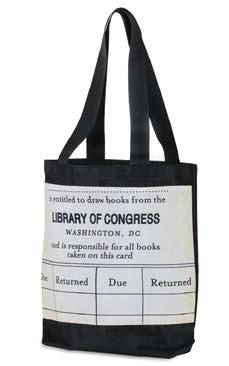
Product #21301023
Price: $25
If there’s a special place in your heart for old library cards, you’ll want to check out this nostalgic tote.
26 LIBRARY OF CONGRESS MAGAZINE
▪ Order online: loc.gov/shop ▪ Order by phone: 888.682.3557
SOUNDS OF MUSIC
New fund supports performances and instrument collections.
The sounds of music reverberate throughout the Library, thanks to philanthropic gifts from friends throughout its history.
Elizabeth Sprague Coolidge generously funded the Coolidge Auditorium and endowed the concert program. Gertrude Clarke Whittall presented the Library with five Strads and the funds to care for them. Dayton C. Miller donated the world’s largest flute collection, each instrument with its own story.
Year after year, we are astounded by the generous support of the Library’s friends. Another of them is Elinor D. Sosne. She was an excellent flutist in high school and college but pursued careers in anthropology and then in law. For two decades, she served as an attorney at the Securities and Exchange Commission.
Throughout her life, music brought Sosne joy. She was a devotee of the Library’s concerts and musical endeavors for over 30 years, attending performances in the Coolidge Auditorium, usually accompanied by professor James Henretta.
In 2021, the Elinore D. Sosne Fund for Music in the Library of Congress was established in her memory with a generous gift to support chamber music concerts. To celebrate her love for the flute, the fund also supports programming for and care of the Miller flute collection.
On Nov. 14, 2022, the Library was honored to hold the inaugural Elinor D. Sosne concert in the Coolidge. Henretta attended along with Sosne's sister, Diane Sosne, and friends for a world-class performance by eminent flutist Emmanuel Pahud and pianist Alessio Bax. The performance delighted a full house of flute students, musicians and music lovers. That concert was only the beginning for the Sosne endowment. For years to come, the endowment will enliven the musical community through performances and promote the Library’s musical instrument collections as a source of inspiration, all in memory of Sosne.
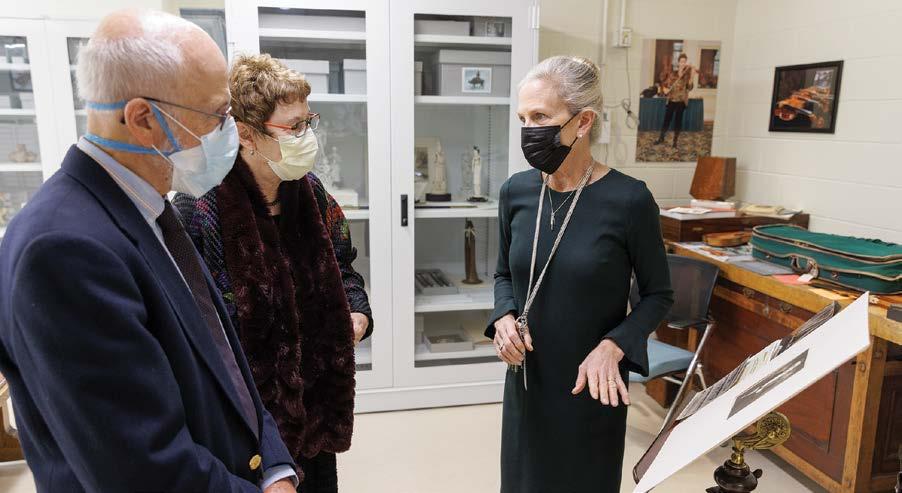
Whether you love the flute, the viola or the harpsichord or, like Sosne, find joy in music, you can make a donation to ensure that the Library’s halls are filled with music for generations.
Support the Library loc.gov/support
MORE INFORMATION
▪ James Henretta and Diane Sosne (center) examine items from the Dayton C. Miller flute collection with Carol Lynn Ward-Bamford, the Library’s curator of musical instruments. Shawn Miller
MARCH/APRIL 2023 LOC.GOV/LCM 27 SUPPORT
LAST WORD
MIDORI
What is the relationship between musicians and musical instruments and the music that, together, they ultimately produce? To me, that is almost a spiritual question, of alignments, of meldings of purpose.
I consider my violin to be my partner in music-making. It is almost 300 years old, with so much history animating it. Any number of renowned violinists have played this august instrument over time, so that it is a repository of our legacy of iconic music — a keeper of many secrets, as it were — now abetting me in my own forays as an interpreter of so many amazing works that have enriched and continue to enrich humankind through the centuries.
For me, this instrument is all but alive. When I hold my violin in my hands, I know it so well. I feel that the violin has a personality, it has force of character, and its particularity has become a part of what I do.
After several hundred years, this violin does not merely defer. A long-lived instrument, one that requires ongoing maintenance (at certain times it must be deeply cleaned, or a new bridge is needed, the fingerboard planed, etc.), it is changeable and it is challenging. It plays differently from day to day, depending on the weather and the atmospheric conditions in a performance space. But that constant challenge, of responding to the different colors this great instrument provides in different circumstances — it inspires me.
An instrument of so many moods and needs, my violin forces me to work hard to commune with it successfully. In return, it has so much to offer, an incredible range of colors and sounds. Its sound can be rich but also velvety at times and light as a feather at other times. The music it is prepared to yield is crystal clear, deep and complex — all at the same time.
A great instrument, tested over centuries, ever changing and ever deepening, does not merely succumb to any player, but through joined effort it offers great rewards. My violin may be a “diva” (as my luthier calls it), but I respect its lineage and its prideful uniqueness. Music-making is a living process, and I work hard to bring out this instrument’s brilliance, allowing our music to reach toward a higher place.
This partnership spurs me ever forward, now over decades. I continue to strive to interpret great compositions of many eras both thoughtfully and boldly, while carrying our art form forward into future realms. In today’s increasingly interconnecting world, I pursue the added goal of bringing music to people who in some ways are left out, who often don’t have ready access to live performance (because of trying circumstances or where they live) — in the doing providing joy, consolation, solace, healing, contemplation. My violin, finicky as it may be, has survived and thrived over centuries, and so long as I treat it carefully and lovingly, we can sing out together, sharing an endless range of timeless ideas and beauty — and, hopefully, inspiration.
—Midori is a classical violinist who made her debut with the New York Philharmonic at age 11. She plays the 1734 Guarnerius del Gesù “ex-Huberman” and uses four bows — two by Dominique Peccatte, one by François Peccatte and one by Paul Siefried.
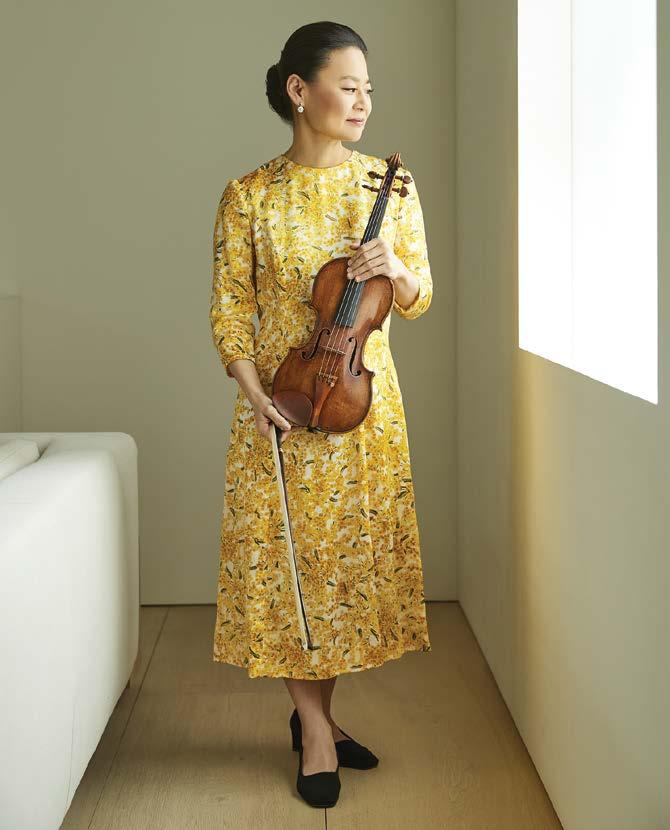
28 LIBRARY OF CONGRESS MAGAZINE
NIGEL PARRY
▪ Musicians play a flute and a lute in this reproduction of a 16th-century painting by French artist François Clouet found in the Dayton C. Miller collection of
 flutes. Music Division
flutes. Music Division



PRESORTED STANDARD POSTAGE & FEES PAID LIBRARY OF CONGRESS WASHINGTON, DC PERMIT No. G-103 OFFICE OF COMMUNICATIONS 101 INDEPENDENCE AVE. S.E. WASHINGTON, DC 20540-1610 DATED MATERIAL OFFICIAL BUSINESS PENALTY FOR PRIVATE USE $300 LOC.GOV JOIN IN: VOLUNTARY ASSOCIATIONS IN AMERICA NOT AN OSTRICH: & OTHER IMAGES FROM AMERICA’S LIBRARY THE GUTENBERG BIBLE More information loc.gov/exhibits





























 BY MARK HARTSELL
BY MARK HARTSELL





























 flutes. Music Division
flutes. Music Division



